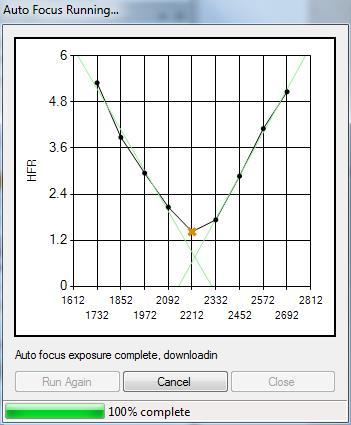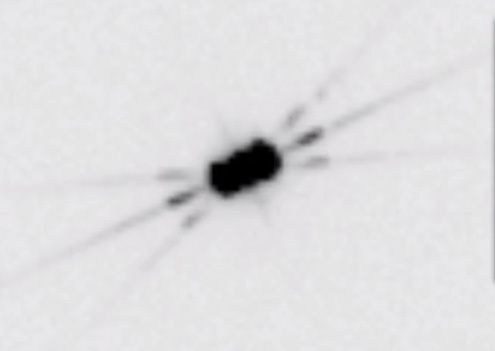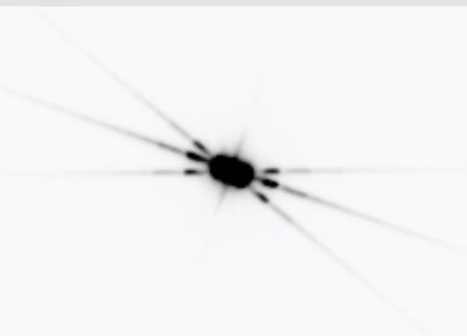That is certainly not an accurate number. Just meaning for the “Vast majority of the sky”…
Thanks,
Jared
That is certainly not an accurate number. Just meaning for the “Vast majority of the sky”…
Thanks,
Jared
Understood–but with longer exposures, and especially if dark subtracted, maybe it IS 99%?
Rodd
Here’s a report back having started the thread. Equipment: C14 working @ F6 (2.1 metres), Atik 460EX / EQ8. Lakeside Focuser on the primary. Conditions: terrible! No wind, but poor transparency and light polluted skies. Upped the exposure to a whacking 20 seconds with Lum filter. Min star size 6 produced starriest fields. Went over to M102 and NGC5907 (galaxies) and the cores were not detected as stars. Good. Same per NGC6229 - small globular. Still not getting enough stars to be sure of a good AF run, but that’s down to my local conditions. I’ve been playing with step sizes all the way from 20 right up to 200. Surprisingly on my set up higher step sizes produced the best results with a good V curves. In the end I settled at 120. Donuts were handled well - but I suspect it all depends on your FOV and whether some stars remain solid to anchor things. Final run of the night in richer star fields near Lyra was on the button. See below. Backlash compensation used - to be on the safe side set at 450 IN, but I could use lower numbers. Look forward to trying things out when the dark skies return on some of my more obscure galaxy targets. Again thanks to Ken and Jared for the software.
.


That B-mask image looks right on. Quick question–how do you get your C14 to F6? I use a C11Edge with teh Celestron reducer can acheive F7–will your reducer work on the edge system?
Rodd
Rodd
I’m currently using a Celestron F6.3 FR - my C14 is not Edge. I’ve pushed things a little re spacing, but my sensor is pretty small and the stars at the edge are fine. Plate solves to about 2100mm or 0.89 px/sec binned 2x. I’m always checking with the mask to see how close SGP can get me and whether in my system it’s reliable enough to leave alone. If it gets it wrong it’s virtually always by 40 or 50 steps INSIDE focus.
Richie
When things don’t hit the spot this is a typical result for me - wrong on the INSIDE. In this case 50 step size
.

I use a Bmask now–the image you posted would not pass my eye using a bmask–I am pretty careful and really try to get that spike dead center–. Will autofocus be a huge imrpovement? Is it possible that the image can be way out of focus but the central spike look like its centered? Or will autofocus just save me time and effort, but the focus quality will remain as it is?
I would increase your step size. You want your max HFR to be a little higher than that, probably in the range of 4ish. I’d go to 65 steps and see how that works out.
You can expect to get perfect focus with both a B-Mask and Auto Focus. If you’re good at using a B-Mask then you won’t see an improvement over the actual focus of the image (as both will be in focus). But what you will notice is that Auto Focus is faster and requires less effort on your part (as in none)
Thanks,
Jared
quote=“Rodd, post:10, topic:5519”]
whenever I image a target that has a bright feature, like a galaxy core, autofocus will not work.
[/quote]
I image galaxies, clusters and nebula all the time. The only time I get issues with Focus is if my RCT is out of collimation. I initially had issues as, also coming from Maxim / FM, I was using exceedingly short AF exposures. I now use AF exposures around the 10-second mark and the problems went away.
Lovely image. Big FOV - using a refractor?
Rodd
As Jared states I the BMask is pretty definitive. The virtue of SGP is automation with the goal to equal what the mask is giving (as far as I’m concerned).
Richie
Thats good news all around. It means I AM actually getting good focus as well as SGP will be able to duplicate it without me having to (slew, focus, slew, manually frame!). How hard is it to set up? Can I start with a step size–say 10 and see if it works and proceed from there, modifying as needed (trial and error), or do I really need to measure it with a ruler (or caliper)?
What focuser are you using Rodd?
I use the Boss II kit digital system with Starlight instruments stepper motors on the Televue np101is and the C11Edge (this one has a crayford that allows me to lock down the primary and focus with no image shift). The step sizes for these motors ate 1.04um I think. For the Tak TOA 130 I use a starlight instruments positronic motor with the stock 4" focuser.(step size of 2.04 I think).
I am talking myself out of AF I think!
FLT 98 with a reducer - QSI camera - autofocused by SGP for each filter and if the temp changed 0.5C. (I now have established offsets for each filter using a GoldFocus mask and only AF through a Lum filter.)
Total exposure ~10 hours.
Thx for following up. As a note (possibly to anyone reading this in the future) it is almost always the case that higher step sizes will work better… they will produce data measurement with greater deviation and, because of this, the trend becomes much more apparent.
Ken
I meant to ask - in simple terms what does the weighted average method do to arrive at a focus point?
Thx
Weighted average is the fallback method for focus calculation… where the intersection of two linear regressions is preferred.
It’s certainly nothing complex. When using this method, SGPro grabs the 3 lowest consecutive points (lowest HFR). This will normally be a very small “V”. If the point on the left has the same HFR value as the point on the right, the focus position of the center point will be selected (equal weight). If the point on the left has a higher HFR than the point on the right, the left point will weight the focus point selection and the result will be a focus point slightly to the left of the center point.
Thanks Ken.
Rodd
Just run the AF routine and try a 60+ step size. Watch the graph. What’s the highest reading and what’s the lowest HFR? Aim for at least 3x lowest. To increase just up the step count. I’ve ended up at around the 100 mark with a similar set up. Use longish exposure if your skies are poor…10 secs plus. . Test the result against your BMask. I don’t think there’s a one size fits all and some use small steps others large with similar gear… Actually it’s fun getting it to work. Richie